Abstract Factory
Intent
Providing an interface for creating families of related or dependent objects without specifying their concrete classes.
Also Known As
Kit
Motivation
A user interface can have different look-and-feel families - e.g. UIs on Windows look very differently compared to MacOS. These different families have the same types of widgets which all share the same look-and-feel standard - scroll bars, windows, buttons.
To be portable across multiple such standards, an application should not hard-code the first standard it happened to implement.
How to solve this?
- Define an abstract
WidgetFactorywhich has factory methods for each type of widget - The factory methods instantiate concrete types, based on the look-and-feel family being used, but the client gets an abstract class instead
- The factory also enforces that widgets of a particular family only use widgets of the same family

Applicability
When to use Abstract Factory?
- When a system needs to be unaware of how its products are created, composed & represented
- When a system needs to be configured with one among a multiple family of products
- You need to enforce a constraint where a product of a given family can only use other products of the same family
- To provide a class library of related products and you only want to expose their interfaces, rather than concrete types
Structure

Participants
- AbstractFactory (WidgetFactory) - an interface for operations that create abstract products of the same family
- ConcreteFactory (MotifWidgetFactory, PMWidgetFactory) - implement the factory operations for the given family
- AbstractProduct (Window, ScrollBar) - declares the interface for a product type, which clients have access to
- ConcreteProduct (MotifWindow, MotifScrollBar) - a concrete product which adheres to a family, created by
ConcreteFactory - Client - uses only the interfaces for the provided product types
Collaborations
- A single instance of
ConcreteFactoryis created at runtime. This instance creates products of a given family. Clients which want to use a different family should use a different factory implementation. AbstractFactorydefers creation of product objects to itsConcreteFactorysubclass
Consequences
- It isolates concrete classes - the factory classes control which instances your application use. Client code doesn’t have direct access to concrete class types.
- It makes exchanging product families easy - simply change the concrete factory implementation you’re using to instantiate your objects.
- It promotes consistency among products - you can enforce that products of a given family only work with other products of the same family.
- Supporting new kinds of products is difficult - e.g. adding a
TextBoxwhen one is not supported yet. This involves extending the factory interface & all concrete implementations.
Implementation
Useful techniques for implementing Abstract Factory:
- Factories as singletons - an app usually needs only one instance of a factory, so it’s best to complement this with the Singleton pattern
- Creating the products - The most common way is to use factory methods, but if many product families are possible, you can also use the Prototype pattern.
- Defining flexible factories - usually, factories have a separate method for each product type, which makes adding new product types cumbersome.
Alternatively, you can have a single
make(ProductType pt)factory method which creates a new product based on the type passed. The problem with this approach is that you’ll need to type cast the specific product returned on the client-side.
Sample Code
Example default MazeFactory:
public class MazeFactory {
public Maze makeMaze() { return new Maze(); }
public Wall makeWall() { return new Wall(); }
public Room makeRoom(int n) { return new Room(n); }
public Door makeDoor(Room r1, Room r2) { return new Door(r1, r2); }
}
Usage:
public class MazeGame {
Maze createMaze(MazeFactory factory) {
Maze aMaze = factory.makeMaze();
Room r1 = factory.makeRoom(1);
Room r2 = factory.makeRoom(2);
Door theDoor = factory.makeDoor(r1, r2);
aMaze.addRoom(r1);
aMaze.addRoom(r2);
r1.setSide(North, factory.makeWall());
r1.setSide(East, theDoor);
r1.setSide(South, factory.makeWall());
r1.setSide(West, factory.makeWall());
r2.setSide(North, factory.makeWall());
r2.setSide(East, factory.makeWall());
r2.setSide(South, factory.makeWall());
r2.setSide(West, theDoor);
return aMaze;
}
}
How to create an enchanted maze?
public class EnchantedMazeFactory extends MazeFactory {
@Override
public Room makeRoom(int n) { return new EnchantedRoom(n); }
@Override
public Door makeDoor(Room r1, Room r2) { return new DoorNeedingSpell(r1, r2); }
}
How to create a maze with bombs?
public class BombedMazeFactory extends MazeFactory {
@Override
public Room makeRoom(int n) { return new RoomWithBomb(n); }
@Override
public Wall makeWall() { return new BombedWall(); }
}
Notice that the MazeFactory is a concrete class which is subclassed to reuse its default implementations.
This avoids having to define a separate AbstractMaze interface. This is a typical way to implement Abstract Factory.
Related Patterns
Abstract factory classes are often implemented via factory methods (Factory Method), but they can also be imlpemented via prototypes (Prototype).
A concrete factory is usually a Singleton.
 00.Introduction - maze-classes
00.Introduction - maze-classes